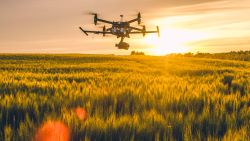 You could be forgiven for thinking that drones are old news. But, thanks to some rapid technological advances, we could actually be on the cusp of a commercial drone revolution.
You could be forgiven for thinking that drones are old news. But, thanks to some rapid technological advances, we could actually be on the cusp of a commercial drone revolution.
According to a recent report, there will be more than 900,000 drones in UK skies by 2030, contributing £45bn to the UK economy. This could reduce carbon emissions by 2.4m tons, and even create 650,000 jobs. But how is the use of drones evolving, and could your organization benefit?
How is the use of commercial drones evolving?
Drones can be used in a wide range of applications. Some of the these, like inspecting the UK’s buildings, power lines, offshore energy facilities, roads, railways and
industrial facilities, are already very well established. However, as prices fall and the technology advances, we can expect drones to be used in ever more innovative ways in the coming years. Here are just a few of the ways we could see commercial drones used in the next decade:
1. Inventory management, intralogistics, and security
Many big retailers and delivery groups are already investing heavily in delivery drones. However, in the not-too-distant future, drones are also likely to start transforming operations within the warehouse.
The main benefit is expected to be for inventory management. Instead of warehouse workers manually counting items and scanning barcodes (often at height), a drone with the right equipment can do this automatically. The ability to programme flight paths could also mean that drones are used to transport parts and tools around the warehouse.
They also offer obvious security advantages within the warehouse setting. Instead of a security guard monitoring a large warehouse on foot, the same guard could watch live feeds from a whole fleet of camera equipped drones.
2. Construction
The use of drones is already fairly well established in the construction industry. However, by combining drones with 3D technology, it is likely we’ll see drones not just surveying, but used in actual construction process itself. A team of researchers from Imperial College London and the Swiss Federal Laboratories of Materials Science and Technology have developed a new system called Aerial Additive Manufacturing (Aerial-AM). The system allows a ‘team’ of drones work together to carry out repair work on a building, monitored by a human controller on the ground.
3. Providing mobile signal to remote areas
North Wales mountain rescue services will soon trial the use of a drone to provide an airborne mobile network in remote parts of Snowdonia. The drones will be equipped with devices providing 4G and 5G connectivity, enabling stranded, injured, or lost hikers to contact emergency services. If successful, the trial could provide the blueprint for providing signal to other remote areas – including maritime environments.
4. Agriculture
Plant protection spraying, fertilizer spreading, and broadcast sowing via drone could soon become a reality for UK farmers. This promises to reduce the costs of using heavy ground machinery which is often limited by a rainy climate and mountainous terrain.
What do organisations need to consider before investing in drones?
The regulations for drones are constantly evolving as the sector matures.
The Drone and Model Aircraft Code, published by the CAA, is a great place for an overview of everything an organisation needs to know before flying a drone in the UK.
If you would like to understand the regulations in more detail then we would recommend reading CAP 722: Unmanned Aircraft System Operations in UK Airspace - Guidance.
What about standards?
As the use of drones evolves, standards are being developed to support commercial operators. ISO 21384-3 – Unmanned Aircraft Systems is the first international standard for drones, and provides best practices for safety risk management, hazard identification, risk analysis for developing risk controls.
What’s next?
The potential commercial benefits offered by drones are becoming clearer by the day, but we’re still only scratching the surface of what’s possible. As the technology matures, we’ll see drones delivering efficiencies and creating value for businesses in all manner of surprising ways. Legislation and standards will evolve to keep up, and organisations will likely require support to assess the feasibility of new initiatives involving commercial drones. BSI can be your support.
If you have any questions about how standards can help your organisation get to grips with drones, BSI members can get in touch with the Knowledge Centre’s information experts.

 You could be forgiven for thinking that drones are old news. But, thanks to some rapid technological advances, we could actually be on the cusp of a commercial drone revolution.
You could be forgiven for thinking that drones are old news. But, thanks to some rapid technological advances, we could actually be on the cusp of a commercial drone revolution.